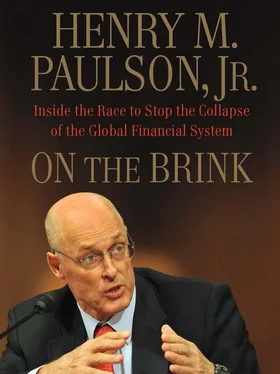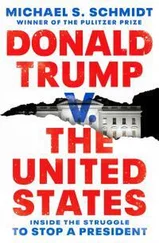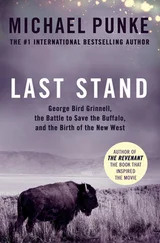Oversight was weak. They had dual regulators: the Department of Housing and Urban Development oversaw their housing mission, while the Office of Federal Housing Enterprise Oversight (OFHEO), an overmatched HUD offshoot, created in 1992, kept watch on their finances.
In short, Fannie and Freddie were disasters waiting to happen. They were extreme examples of a broader problem that was soon to become all too evident—very big financial institutions with too much leverage and lax regulation.
But change was hard to come by. The GSEs wielded incredible power on the Hill thanks in no small part to their long history of employing—and enriching—Washington insiders as they cycled in and out of government. After accounting scandals had forced both GSEs to restate years of earnings, their CEOs were booted, and House and Senate efforts at reform broke down in a dispute over how to manage the size and composition of the GSEs’ portfolios. These had been expanding rapidly and moving into dicier assets—exposing Fannie and Freddie to greater risk.
Answering one of my many questions, Nason pointed out a simple fact: “Two-thirds of their revenue comes from their portfolios, and one-third comes from the securitization business.”
I didn’t need to hear much more than that. “That’s why this is next to impossible to get done,” I said. Their boards had a fiduciary duty to resist giving up two-thirds of their profit, and they would.
The administration, I concluded, had to be more flexible to accomplish any meaningful reform. My idea was to work off a bill that had passed the House the previous year by a three-to-one margin. It would have established a new entity, the Federal Housing Finance Agency, and given it powers, equal to those of banking regulators, to oversee Fannie’s and Freddie’s portfolios.
This House bill had passed with bipartisan support, and I was convinced we could negotiate tougher standards. The White House, however, had opposed it. Convinced that Fannie and Freddie were simply too powerful for their regulator to control, it wanted Congress to write clear statutes limiting the investment portfolios. The administration’s thinking was aligned with a Republican-backed Senate bill, which authorized a more powerful regulator and capped the GSEs’ portfolios. But once the November midterm elections gave the Democrats control of both chambers, the need for flexibility became clear.
Fortunately, I had been forging relationships on both sides of the aisle. One was with longtime Democratic congressman Barney Frank of Massachusetts. With his gravelly voice and pugnacious demeanor, Barney is famous not only inside the Beltway but, for wildly different reasons, to fans of The O’Reilly Factor and Saturday Night Live . Barney’s a showman with a quick, impromptu wit. But he’s also a pragmatic, disciplined, completely honorable politician: he never once violated a confidence of mine. Secure in his seat, he pushes for what he thinks is right. To get things done, he’s willing to deal, to take half a loaf.
Right from the start, he indicated that he was willing to work with me on GSE reform, hashing out the issues of portfolio limits and regulation. Even as we made progress, I ran into opposition inside the administration, leading to one of the worst meetings I would ever have at the White House.
On November 21, David Nason and I met in the Roosevelt Room with HUD secretary Alphonso Jackson and a large group of White House staff that included NEC director Al Hubbard, White House counsel Harriet Miers, and deputy chief of staff Karl Rove. Across the hall from the Oval Office, the Roosevelt Room serves as a daily meeting room for White House staff. With a false skylight and no windows, it’s designed for serious business, and this meeting was no exception.
I explained my position that we should be willing to negotiate on the GSEs, then we went around the table to get people’s opinions. Hubbard declined to declare himself, but everybody else was dead set against my approach. I was used to dissent and debate, but I couldn’t remember the last time everyone in the room had opposed me on an issue. I found this frustrating in the extreme. They were right on principle, but if we didn’t compromise, there would be no reform.
My response, more or less, was a bit petulant: “I know better than all of you on this. I’m going to send a memo to the president.”
I drafted my memo and sent it around. Rove protested that it was disrespectful of the administration’s no-compromise position, and he offered to help me rewrite it over Thanksgiving weekend. I swallowed my pride and accepted. In any event, Rove made clear that I would get my way.
“You’re going to win this because the president will not want to undercut his new Treasury secretary,” he said quietly.
A few days later, on the Sunday after Thanksgiving, I attended a meeting with President Bush in his residence. At the end, he took me aside, handed the memo back to me, and said simply, “Hank, that’s why I brought you here. You go do it.”
We didn’t get a bill passed in the lame-duck session, but Barney made good on his promise to honor the agreements we’d reached after the new Congress came in the following year. By the end of our negotiations in late May, we had pushed a far-from-perfect bill through the House. But our efforts went nowhere in the Senate. The new Banking Committee chairman, Chris Dodd, was running for president so for all practical purposes, the important committee business was put on hold, and the Senate did nothing on the GSEs.
I don’t have a lot of patience for people who came out of the woodwork after we put Fannie and Freddie into conservatorship and declared: “Here’s what I said before: I saw it coming.” Anyone can make a speech pointing out a problem, but the way you solve that problem is by working hard, hacking it out, and, frankly, eating a little dirt.
I came to Washington determined to compromise when necessary to make change happen. But that is not the culture of our capital. It would take until July 2008 to get meaningful GSE reforms passed. By then it was almost too late.
Thursday, August 9, 2007
The crisis in the financial markets that I had anticipated arrived in force on August 9, 2007. It came from an area we hadn’t expected—housing—and the damage it caused was much deeper and much longer lasting than any of us could have imagined.
I was in my car on my way to the Federal Reserve when I got a call shortly after 7:00 a.m. from Clay Lowery, the acting undersecretary for international affairs, who told me that the European markets were in turmoil. Earlier that morning, continental time, BNP Paribas, France’s biggest bank, had halted redemptions on three investment funds that held mortgage-backed bonds, citing a “complete evaporation of liquidity” that had made it impossible to value “certain assets fairly regardless of their quality or credit rating.”
The action was disturbing, but it came with news that was even more alarming: Europe’s credit markets had tightened dramatically, as banks hesitated to lend to one another. In response, the European Central Bank (ECB) had announced that it would make as much money available as European banks needed at its official rate of 4 percent. Euro-zone overnight borrowing rates, which normally tracked the official rate, had reached 4.7 percent. Within a couple of hours of its announcement, the ECB would reveal that 49 banks had borrowed a stunning total of 94.8 billion euros, or $130 billion. That was more than the central bank had lent after the 9/11 attacks.
I sped on to my scheduled breakfast with Ben Bernanke. I was eager to see him—we’d skipped the previous week’s breakfast since I had only just returned from China. Before I’d come to Washington, I’d hardly known Ben, but I liked him immediately, and soon after I settled in at Treasury, he and I began to meet for breakfast every week. It was such an established routine, and I’m enough of a creature of habit, that when I arrived at the Fed I could count on seeing, already set out for me, a bowl of oatmeal along with glasses of orange juice, ice water, and Diet Coke.
Читать дальше












